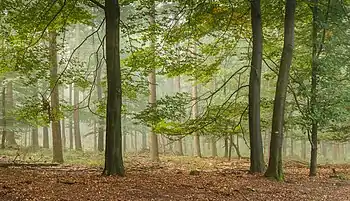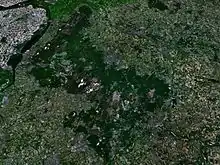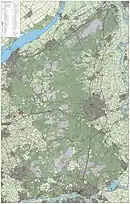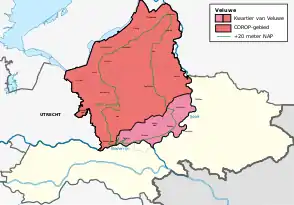Veluwe
The Veluwe is a forest-rich ridge of hills (1100 km2) in the province of Gelderland in the Netherlands. The Veluwe features many different landscapes, including woodland, heath, some small lakes and Europe's largest sand drifts.

The Veluwe is the largest push moraine complex in the Netherlands, stretching 60 km from north to south, and reaching heights of up to 110 metres. The Veluwe was formed by the Saalian glacial during the Pleistocene epoch, some 200,000 years ago. Glaciers some 200 metres thick pushed the sand deposits in the Rhine and Maas Delta sideways, creating the hills which now form most of the Veluwe. Because the hills are made of sand, rain water disappears rapidly, and then it flows at a depth of tens of metres to the edges where it reaches the surface again[1] .
Originally the Veluwe was surrounded by a string of swamps, heavily populated with game such as deer and wild boar because these areas offered rich vegetation to feed on. Since the 1990s many plans are underway, or have already been implemented, to restore these wetlands by blocking the drainage systems built by farmers during the last 150 years. This results in very dry heathland changing into wetland within a span of just a few hundred metres. The Wisselse Veen near the village of Epe, on the northeastern Veluwe, offers a good example of this.
Etymology
Veluwe derives from Proto-Germanic *falwaz (pale, fallow) and *awjō (island).[2] The name corresponds to "fallow lands" in English and probably was used in opposition to the fertile "good lands" of the Betuwe (from *bataz, good, and *awjō, island) to the south.
Geography

There are 21 municipalities in the Veluwe region: Apeldoorn, Arnhem, Barneveld, Brummen, Ede, Elburg, Epe, Ermelo, Harderwijk, Hattem, Heerde, Nijkerk, Nunspeet, Oldebroek, Putten, Renkum, Rheden, Rozendaal, Scherpenzeel, Voorst and Wageningen.
Flora and fauna
There are both coniferous and deciduous forests on the Veluwe, and some 500 different plant species can be found. The region is also home to many different species of animals, such as wild boar, several species of deer (like the roe deer, red deer and fallow deer), several species of snakes (including the common viper), pine martens, foxes, and badgers. Furthermore, the bird raven was successfully reintroduced, and the exotic Reeves's muntjac and mouflon can sometimes be seen. Furthermore there live semi-wild and wild cattle and horses like both semi-wild and wild Highland cattle in multiple areas of the veluwe, semi-wild Sayaguesa cattle and two semi-wild horse breeds: New-forest pony and Icelandic pony. Since not long ago the Wolf is officially back with a female and male pair in the northern veluwe (spring 2019) who had their for to offspring in the summer of 2019 and one female wolf in middle veluwe. The prognosis are that many more wolves will reclaim the area. The European bison is also reintroduced as pilot in a fenced area in the Radio kootwijk reserve and the golden jackal is reaching the area, from which they are not native, but since the jackals reach the area all by their own they are seen as a welcome and new native species.
Developments
Parts of the Veluwe that have been separated from each other by roads, towns and farmland are being reconnected by returning farmland to nature and creating wildlife crossings over highways. In 2012, nine of these overpasses had been built, each one about 50 metres wide and covered with sand and vegetation to encourage animals to use it.[3] Wildlife corridors connecting the Veluwe to other wildlife areas such as the Oostvaardersplassen in the Netherlands are being developed and further connections to Germany are an option.[4] It is hoped that by doing so the genetic diversity of the wildlife population will increase.
In order to turn the entire Veluwe into one IUCN (Category II) standard National Park a number of actions have been taken, or are planned, including: bungalow parks located in a more sensitive natural area have been removed; taking down remaining fences, as around De Hoge Veluwe; an old industrial zone near the village of Renkum was cleared away because it blocked a valley that was important for the migration of wildlife; and a military complex near Nunspeet was removed instead of being redeveloped as a business area.
Tourism and recreation
The Veluwe is a tourist destination, especially for Dutch people wanting to go on a short vacation in their own country. Campsites and bungalow parks are the preferred place to stay for most visitors. There are more than 500 of these sites, most located on the outskirts of the natural area.
Tourist attractions in the area include four zoos, over 50 museums including the Kröller-Müller art museum, and the royal palace Het Loo at Apeldoorn. The National Sports Centre Papendal, a large sports complex and Olympic Games training facility, is located in the south of the Veluwe near Arnhem.
References
- Martens, Anne (April 30, 2008). "Stuwwal". Geologie van Nederland. Geologie van Nederland. Retrieved December 5, 2019.
- Nederlands Etymologisch Woordenboek - J. de Vries
- (in Dutch) Province of Gelderland, factsheet wildlife crossings
- L. Verbeek (Queen’s Commissioner of the Province of Flevoland), A.E. Bliek-de Jong (Deputy Queen's Commissioner) (October 2010). "Oostvaardersland. Strengthening biodiversity and the economy in the Netherlands" (PDF). Presentation at the Convention on Biological Diversity, Nagoya, Japan. Archived from the original (PDF) on 17 October 2014. Retrieved 20 August 2013.CS1 maint: uses authors parameter (link)
External links
| Wikimedia Commons has media related to Veluwe. |
- Veluwe Tourist Information (in Dutch, English, and German)


%252C_Veluwe%252C_the_Netherlands.jpg.webp)
